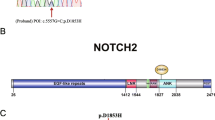Abstract
Background
Premature ovarian insufficiency (POI) occurs in women before the age of 40 years, accompanied by amenorrhea, hypoestrogenism, hypergonadotropinism, and infertility. The pathology of POI is complex and the molecular genetic mechanisms are poorly understood. Bone morphogenetic protein 15 (BMP15) plays a crucial role in oocyte maturation and follicular development through the activation of granulosa cells. Dysfunction of BMP15 causes ovarian dysgenesis and is related to POI. Identifying pathogenic variants contributes to revealing genetic mechanisms and making clinical diagnoses of POI.
Methods
The study involved two sisters diagnosed with POI. Whole-exome sequencing (WES) was performed to identify causative genes. Sanger sequencing was used to validate the mutations in patients with POI and members of the family with no clinical signs or symptoms. The effect of the novel mutations on the BMP15 structure was analyzed by PSIPRED. By over-expressing wild-type (WT) or mutant BMP15 plasmids in vitro, a functional study of the BMP15 mutant was conducted by real-time qPCR and western blotting. Through cocultivation with HEK293T cells, the effects of secreted BMP15 WT and variants on granulosa cell proliferation and apoptosis were detected through a cell counting kit-8 assay and flow cytometric analysis.
Results
We identified biallelic variants in BMP15, c.791G > A (p. R264Q) and c.1076C > T (p. P359L), in two siblings with POI. Both sisters carried the same biallelic variants, while the other female members of their family carried only one of them. Structural prediction showed that the variants have not affected the secondary structure of BMP15 but may change the conformation of water molecules around protein surfaces and thermal stability of BMP15. Real-time qPCR showed no significant difference in mRNA levels among WT and the two variants. Western blotting indicated a reduction in BMP15 expression with the c.791G > A and c.1076C > T variants compared to WT. Moreover, mutants 791G > A and 1076C > T impaired the function of secreted BMP15 in promoting granulosa cell proliferation and suppressing cell apoptosis caused by reactive oxygen species.
Conclusions
This study identified novel biallelic variants, c.791G > A and c.1076C > T, of BMP15 in two siblings with POI. Both missense variants reduced the level of the BMP15 protein and impaired the function of BMP15 in promoting granulosa cell proliferation in vitro. Taken together, our findings provide a novel molecular genetic basis and potential pathogenesis of BMP15 variants in POI.




Similar content being viewed by others
References
Jankowska K. Premature ovarian failure. Prz Menopauzalny. 2017;16:51–6.
Goswami D, Conway GS. Premature ovarian failure. Hum Reprod Update. 2005;11:391–410.
Ghahremani-Nasab M, Ghanbari E, Jahanbani Y, Mehdizadeh A, Yousefi M. Premature ovarian failure and tissue engineering. J Cell Physiol. 2020;235:4217–26.
Lakhal B, Laissue P, Braham R, Elghezal H, Saad A, Fellous M, Veitia RA. A novel BMP15 variant, potentially affecting the signal peptide, in a familial case of premature ovarian failure. Clin Endocrinol (Oxf). 2009;71:752–3.
Jiao X, Ke H, Qin Y, Chen ZJ. Molecular genetics of premature ovarian insufficiency. Trends Endocrinol Metab. 2018;29:795–807.
Belli M, Shimasaki S. Molecular aspects and clinical relevance of GDF9 and BMP15 in ovarian function. Vitam Horm. 2018;107:317–48.
Persani L, Rossetti R, Di Pasquale E, Cacciatore C, Fabre S. The fundamental role of bone morphogenetic protein 15 in ovarian function and its involvement in female fertility disorders. Hum Reprod Update. 2014;20:869–83.
Rossetti R, Di Pasquale E, Marozzi A, Bione S, Toniolo D, Grammatico P, Nelson LM, Beck-Peccoz P, Persani L. BMP15 mutations associated with primary ovarian insufficiency cause a defective production of bioactive protein. Hum Mutat. 2009;30:804–10.
Di Pasquale E, Beck-Peccoz P, Persani L. Hypergonadotropic ovarian failure associated with an inherited mutation of human bone morphogenetic protein-15 (BMP15) gene. Am J Hum Genet. 2004;75:106–11.
Chang H, Brown CW, Matzuk MM. Genetic analysis of the mammalian transforming growth factor-beta superfamily. Endocr Rev. 2002;23:787–823.
Mottershead DG, Harrison CA, Mueller TD, Stanton PG, Gilchrist RB, McNatty KP. Growth differentiation factor 9:bone morphogenetic protein 15 (GDF9:BMP15) synergism and protein heterodimerization. Proc Natl Acad Sci U S A. 2013;110:E2257.
Mottershead DG, Sugimura S, Al-Musawi SL, Li JJ, Richani D, White MA, Martin GA, Trotta AP, Ritter LJ, Shi J, Mueller TD, Harrison CA, Gilchrist RB. Cumulin, an oocyte-secreted heterodimer of the transforming growth factor-beta family, is a potent activator of granulosa cells and improves oocyte quality. J Biol Chem. 2015;290:24007–20.
Qiao B, Jimenez-Angeles F, Nguyen TD, Olvera de la Cruz M. Water follows polar and nonpolar protein surface domains. Proc Natl Acad Sci U S A. 2019;116:19274–81.
Sanfins A, Rodrigues P, Albertini DF. GDF-9 and BMP-15 direct the follicle symphony. J Assist Reprod Genet. 2018;35:1741–50.
Tiotiu D, Alvaro Mercadal B, Imbert R, Verbist J, Demeestere I, De Leener A, Englert Y, Vassart G, Costagliola S, Delbaere A. Variants of the BMP15 gene in a cohort of patients with premature ovarian failure. Hum Reprod. 2010;25:1581–7.
Mayer A, Fouquet B, Pugeat M, Misrahi M. BMP15 “knockout-like” effect in familial premature ovarian insufficiency with persistent ovarian reserve. Clin Genet. 2017;92:208–12.
Zhang W, Wang J, Wang X, Li L, Pan H, Chen B, Zhu Y, Li T, Cao Y, Wang B. A novel homozygous mutation of bone morphogenetic protein 15 identified in a consanguineous marriage family with primary ovarian insufficiency. Reprod Biomed Online. 2018;36:206–9.
Ferrarini E, De Marco G, Orsolini F, Gianetti E, Benelli E, Fruzzetti F, Simoncini T, Agretti P, Tonacchera M. Characterization of a novel mutation V136L in bone morphogenetic protein 15 identified in a woman affected by POI. J Ovarian Res. 2021;14:85.
Author information
Authors and Affiliations
Corresponding author
Ethics declarations
Conflict of interest
The authors declare no competing interests.
Additional information
Publisher's note
Springer Nature remains neutral with regard to jurisdictional claims in published maps and institutional affiliations.
Supplementary information
Below is the link to the electronic supplementary material.
Rights and permissions
About this article
Cite this article
Zhang, T., Ma, Q., Shen, Q. et al. Identification of novel biallelic variants in BMP15 in two siblings with premature ovarian insufficiency. J Assist Reprod Genet 39, 2125–2134 (2022). https://doi.org/10.1007/s10815-022-02574-1
Received:
Accepted:
Published:
Issue Date:
DOI: https://doi.org/10.1007/s10815-022-02574-1




